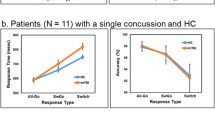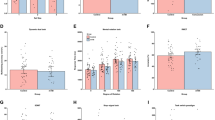Abstract
Poor sustained attention or alertness is a common consequence of traumatic brain injury (TBI) and has a considerable impact on the recovery and adjustment of TBI patients. Here, we describe the development of a sensitive laboratory task in healthy subjects (Experiment 1) and its enhanced sensitivity to sustained attention errors in TBI patients (Experiment 2). The task involves withholding a key press to an infrequent no-go target embedded within a predictable sequence of numbers (primary goal) and detecting grey-coloured targets within the sequence (secondary goal). In Experiment 1, we report that neurologically healthy subjects are more likely to experience a lapse of attention and neglect the primary task goal, despite ceiling performance on the secondary task. Further, attentional lapses on the task correlated with everyday attentional failures and variability of response time. In Experiment 2, the task discriminates between TBI patients and controls with a large effect size. The dual-task yields more errors in both groups than a simple task involving only the primary goal that is commonly used to detect sustained attention deficits in neurologically impaired groups. TBI patients’ errors also correlated with everyday cognitive failures and variability of response time. This was not the case in the simple version of the task. We conclude that the dual-task demand associated with this task enhances its sensitivity as a measure of sustained attention in TBI patients and neurologically healthy controls that relates to everyday slips of attention.



Similar content being viewed by others
Notes
Presentation timing was determined by screen refresh rates. The values presented were converted from screen refresh rates (or ticks) to the milliseconds.
The longer trial presentation time compared to earlier versions of the SART was used to accommodate the mask and response cue.
DMDX display software, The University of Arizona.
CFQ-for-other scores were unavailable for three control participants and two TBI patients.
References
Bellgrove MA, Dockree PM, Aimola L, Robertson IH (2004) Attenuation of spatial attentional asymmetries with poor sustained attention. Neuroreport 15(6):1065–1069
Bellgrove MA, Hester R, Garavan H (2004) The functional neuroanatomical correlates of response variability: evidence from a response inhibition task. Neuropsychologia 42(14):1910–1916
Bonne O, Gilboa A, Louzoun Y, Kempf-Sherf O, Katz M, Fishman Y, Ben-Nahum Z, Krausz Y, Bocher M, Lester H, Chisin R, Lerer B (2003) Cerebral blood flow in chronic symptomatic mild traumatic brain injury. Psychiatry Res 124(3):141–152
Burgess PW (2000) Strategy application disorder: the role of the frontal lobes in human multitasking. Psychol Res 63(3–4):279–288
Dockree PM, Kelly SP, Roche RA, Hogan MJ, Reilly RB, Robertson IH (2004) Behavioural and physiological impairments of sustained attention after traumatic brain injury. Brain Res Cogn Brain Res 20(3):403–414
Fontaine A, Azouvi P, Remy P, Bussel B, Samson Y (1999) Functional anatomy of neuropsychological deficits after severe traumatic brain injury. Neurology 53(9):1963–1968
Kondo H, Morishita M, Osaka N, Osaka M, Fukuyama H, Shibasaki H (2004) Functional roles of the cingulo-frontal network in performance on working memory. Neuroimage 21(1):2–14
Levine B, Dawson D, Boutet I, Schwartz ML, Stuss DT (2000) Assessment of strategic self-regulation in traumatic brain injury: its relationship to injury severity and psychosocial outcome. Neuropsychology 14(4):491–500
Lindgren KA, Larson CL, Schaefer SM, Abercrombie HC, Ward RT, Oakes TR, Holden JE, Perlman SB, Benca RM, Davidson RJ (1999) Thalamic metabolic rate predicts EEG alpha power in healthy control subjects but not in depressed patients. Biol Psychiatry 45(8):943–952
Lopes da Silva FH, Vos JE, Mooibroek J, van Rotterdam A (1980) Relative contribution of intracortical and thalamo-cortical processes in the generation of alpha rhythms, revealed by partial coherence analysis. Electroenceph. clin. Neurophysiol 50:449–456
Manly T, Robertson IH, Galloway M, Hawkins K (1999) The absent mind: further investigation of sustained attention to response. Neuropsychologia 37:661–670
Manly T, Davidson RJ, Heutink J, Galloway M, Robertson IH (2000) Not enough time or not enough attention? Speed, error and self-maintained control in the Sustainted Attention to Response Test (SART). Clin Neuropsychol Assess 3:167–177
Manly T, Anderson V, Nimmo-Smith I, Turner A, Watson P, Robertson IH (2001) The differential assessment of children’s attention: the Test of Everyday Attention for Children (TEA-Ch), normative sample and ADHD performance. J Child Psychol Psychiatry 42(8):1065–1081
Manly T, Lewis GH, Robertson IH, Watson PC, Datta AK (2002) Coffee in the cornflakes: time-of-day as a modulator of executive response control. Neuropsychologia 40:1–6
Manly T, Owen AM, McAvinue L, Datta A, Lewis GH, Scott SK, Rorden C, Pickard J, Robertson IH (2003) Enhancing the sensitivity of a sustained attention task to frontal damage. Convergent clinical and functional imaging evidence. Neurocase 9(4):340–349
McKinlay WM (1981) The short-term outcome of severe blunt head injury as reported by relatives of the injured persons. J Neurol Neurosurg Psychiatry 44:527–533
Portas CM, Rees G, Howseman AM, Josephs O, Turner R, Frith CD (1998) A specific role for the thalamus in mediating the interaction of attention and arousal in humans. J Neurosci 18:8979–8989
Posner MI, DiGirolamo GJ (2000) Cognitive neuroscience: origins and promise. Psychol Bull 126(6):873–889
Posner MI, Peterson SE (1990) The attention system of the human brain. Ann Rev Neurosci 13:25–42
Richardson JTE (2000) Clinical and neuropsychological aspects of closed head injury. Psychology Press Ltd, Hove, East Sussex
Robertson IH, Garavan H (2004) Vigilant Attention. In: Gazzaniga MS (ed) The cognitive neurosciences, 3rd edn
Robertson IH, Manly T, Andrade J, Baddeley BT, Yiend J (1997) ‘Oops!’: Performance correlates of everyday attentional failures in traumatic brain injury and normal subjects. Neuropsychologia 35(6):747–758
Shallice T, Burgess P (1991) Deficits in strategy application following frontal lobe damage in man. Brain 114:727–741
Stablum F, Leonardi G, Mazzoldi M, Umilta C, Morra S (1994) Attention and control deficits following closed head injury. Cortex 30(4):603–618
Stablum F, Mogentale C, Umilta C (1996) Executive functioning following mild closed head injury. Cortex 32(2):261–278
Sturm W, de Simone A, Krause BJ, Specht K, Hesselmann V, Radermacher I, Herzog H, Tellmann L, Muller-Gartner HW, Willmes K (1999) Functional anatomy of intrinsic alertness: evidence for a fronto-parietal-thalamic-brainstem network in the right hemisphere. Neuropsychologia 37(7):797–805
Sturm W, Longoni F, Fimm B, Dietrich T, Weis S, Kemna S, Herzog H, Willmes K (2004) Network for auditory intrinsic alertness: a PET study. Neuropsychologia 42(5):563–568
Stuss DT, Shallice T, Alexander MP, Picton TW (1995) A multidisciplinary approach to anterior attentional functions. Ann N Y Acad Sci 769:191–211
Stuss DT, Toth JP, Franchi D, Alexander MP, Tipper S, Craik FI (1999) Dissociation of attentional processes in patients with focal frontal and posterior lesions. Neuropsychologia 37(9):1005–1027
Stuss DT, Murphy KJ, Binns MA, Alexander MP (2003) Staying on the job: the frontal lobes control individual performance variability. Brain 126(Pt 11):2363–2380
Zigmond AS, Snaith RP (1983) The hospital anxiety and depression scale. Acta Psychiat Scand 67(6):361–370
Acknowledgements
We would like to thank all those from the National Rehabilitation Hospital, Dún Laoghaire, who participated in this research. The Government of Ireland’s Higher Education Authority supported this research. This work was supported by a grant from the Irish Higher Education Authority’s Programme for Research in Third-Level Institutions (8AA. G03007) to Professor Ian Robertson
Author information
Authors and Affiliations
Corresponding author
Rights and permissions
About this article
Cite this article
Dockree, P.M., Bellgrove, M.A., O’Keeffe, F.M. et al. Sustained attention in traumatic brain injury (tbi) and healthy controls: enhanced sensitivity with dual-task load. Exp Brain Res 168, 218–229 (2006). https://doi.org/10.1007/s00221-005-0079-x
Received:
Accepted:
Published:
Issue Date:
DOI: https://doi.org/10.1007/s00221-005-0079-x




